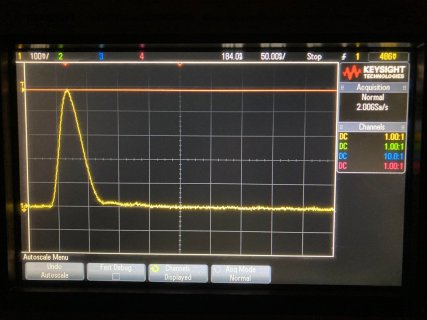Hi everyone,
Hope you are doing well.
I need some help and guidance on building a pulse/frequency counter with a microcontroller under $50. I have analog pulses 486 mV in amplitude and 100 ns wide that are coming from my photodiode TIA at frequency of around 60 Hz. I would like to feed these pulses into a microcontroller and have their frequency displayed on a screen. I wanted to know if the Teensy 4.0 is capable of processing and counting pulses like these. The specs say the analog pins can handle 0 V to 3.3 V, so I think my input voltage will be handled. Are the 100 ns pulses too short to be counted or will the Teensy 4.0 be fine? The pulses are low frequency (60 to 100 Hz) so there is ample time between pulses. I just don't want to miss any pulses. I have attached an image of one of the pulses on the oscilloscope. Thank you.
Hope you are doing well.
I need some help and guidance on building a pulse/frequency counter with a microcontroller under $50. I have analog pulses 486 mV in amplitude and 100 ns wide that are coming from my photodiode TIA at frequency of around 60 Hz. I would like to feed these pulses into a microcontroller and have their frequency displayed on a screen. I wanted to know if the Teensy 4.0 is capable of processing and counting pulses like these. The specs say the analog pins can handle 0 V to 3.3 V, so I think my input voltage will be handled. Are the 100 ns pulses too short to be counted or will the Teensy 4.0 be fine? The pulses are low frequency (60 to 100 Hz) so there is ample time between pulses. I just don't want to miss any pulses. I have attached an image of one of the pulses on the oscilloscope. Thank you.



